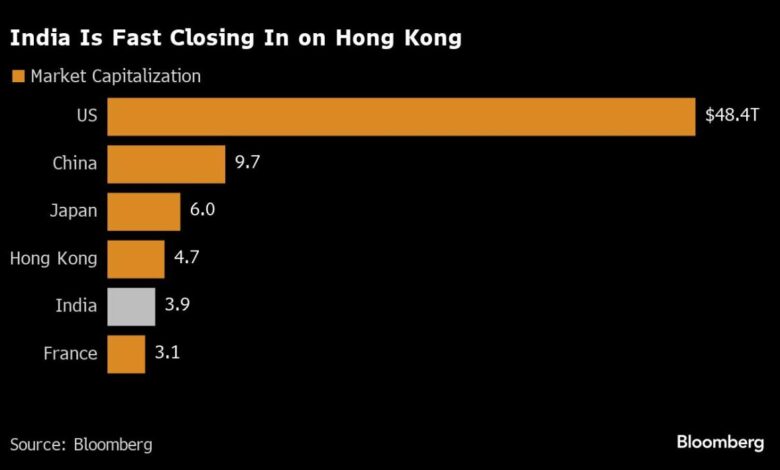
[ad_1]
(Bloomberg) — A surge in investments by individual traders and resurgent foreign inflows have put India’s stock market — the world’s fifth biggest — within striking distance of an unprecedented $4 trillion valuation.
Most Read from Bloomberg
The market capitalization of securities listed on the nation’s exchanges has tripled since the March 2020 pandemic low to reach $3.93 trillion as of Friday, according to data compiled by Bloomberg, with India’s NSE Nifty 50 Index climbing to a fresh record on the day.
The benchmark was up 1.7% in afternoon trading on Monday, leading gains in Asia, after Prime Minister Narendra Modi’s ruling party won three crucial state elections, removing an element of political risk for investors before nationwide polls next year and signaling continuity in government policy.
The potential feat for India’s stock market comes as the world’s fastest-growing major economy positions itself as an alternative to China for global investors and companies alike. Overseas funds have piled more than $14 billion into local shares this year, with the market also getting a steady boost from the retail investing boom that took off during the pandemic. Up almost 14% in 2023, the Nifty gauge is heading for an unprecedented eighth straight year of gains.
India’s economy stands out amid slowing global growth — gross domestic product jumped 7.6% in the three months to September from a year ago — with its appeal further burnished by China’s tepid post-pandemic recovery and its tensions with the West.
The same holds true for Indian stocks, with an MSCI Inc. gauge of local shares on track to beat a global emerging-markets measure by more than 10 percentage points for a third year in a row. The outperformance versus Chinese peers is even more stark, with the Indian gauge poised to outstrip the MSCI China Index by more than 20 percentage points for a third year.
READ: Modi’s Nation-Building Push Spurs $125 Billion Industrials Rally
The nation’s young population and Modi’s efforts to capture a bigger share of global supply chains are helping lure global companies such as Apple Inc. to its shores. Meanwhile, global pension and sovereign wealth managers are flocking to India while growing hesitant on China, according to a new study London-based think-tank Official Monetary and Financial Institutions Forum.
“Besides the structural promise, near-term factors that we believe will drive markets higher are robust activity data, impressive corporate earnings, easing oil prices, strong domestic flows,” JPMorgan Chase & Co. strategists led by Rajiv Batra wrote in a Nov. 30 note.
The stock market’s boom has also sparked a frenzy for initial public offerings, with some of new listings posting stellar gains in recent days.
The risk for India could come from its high valuations. Several investors have voiced concerns the market is overvalued and that the India trade is getting too crowded, raising the odds of a pullback. At the same time, the rising participation of individual investors, many of whom are drawing on advice from unauthorized financial advisers and social media “gurus,” is becoming a concern for the market regulator.
For now though, Modi’s victories in state elections are seen aiding sentiment and raising India’s appeal for foreign investors, who turned buyers of local stocks in November for the first time in three months.
“What it does is give investors increased confidence, and duration to the India trade,” said Matthew Haupt, portfolio manager at Wilson Asset Management in Sydney. “We will likely see continued capital inflows to India.”
NOTE: The market capitalization is calculated from all shares outstanding. ALLX WCAU data does not include ETFs and ADRs as they do not directly represent companies. It includes only actively traded, primary securities on the country’s exchanges to avoid double counting as well. Therefore the values will be significantly lower than market capitalization values of a country’s exchanges from other sources.
–With assistance from Ishika Mookerjee.
Most Read from Bloomberg Businessweek
©2023 Bloomberg L.P.
Source link




